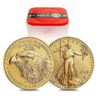- +1 (800) 895-8603
Canada 1/2 oz Gold Maple Leaf .9999 Fine (Random Year)
As low as $1,796.45
| Volume Discount Pricing | ||||
|---|---|---|---|---|
| Quantity | Check / Wire | BitCoin | CC/Paypal | |
| 1 – 9 | 1,805.45 | 1,841.56 | 1,877.67 | |
| 10 – 19 | 1,802.45 | 1,838.50 | 1,874.55 | |
| 20 – 49 | 1,799.45 | 1,835.44 | 1,871.43 | |
| 50 + | 1,796.45 | 1,832.38 | 1,868.31 | |

Product Details: Canada 1/2 oz Gold Maple Leaf .9999 Fine (Random Year)
The Gold Maple Leaf coin was introduced in 1979 and rapidly grew in popularity as the only alternative bullion to the Krugerrand, which was going through distribution issues due to the boycott of apartheid-era South Africa. Gold Maple Leafs minted between 1979 and 1982 have a gold content of .999. In 1982, its purity was raised to .9999, making it the world’s first 99.99% pure gold bullion coin.
The Gold Maple Leaf’s reverse features a detailed sculpture of Canada’s iconic maple leaf by RCM engraver, Walter Ott. This had been the same leaf design used since the coin’s inception. The obverse features the profile of Queen Elizabeth II. This image has been updated three times since 1979.
In 2013, a laser-micro-engraved textured maple leaf privy mark was added on a small area of the reverse (Maple Leaf) side of the coin. In the center of this mark is the numeral denoting the coin’s year of issue, which is only visible under magnification. In 2015, the radial lines on the coin’s background on both sides of the coin were added.
Starting in 2014, all gold Maple Leafs featured three distinct, enhanced security characteristics: advanced engraving, laser-marking technology and precision radial lines. The Mint combines these features with their Bullion DNA to provide instant authentication for registered 1 ounce Gold and Silver Maple Leaf coins. (Bullion DNA is not featured on fractional sizes.) This registration process features Digital Non-destructive Activation (DNA)technology that captures images encrypted with a string of codes, and stores them in the mint’s secure database.
The Royal Canadian Mint’s Bullion DNA Reader technology can authentication of Gold Maple Leaf coins dated 2014 and later, and Silver Maple Leaf coins dated 2015 and later in real time.
INTERESTING NOTE
In 2007, the Royal Canadian Mint unveiled a 100kg Gold Maple Leaf coin that was 99.999% pure. It had a face value of $1 million, but it’s metal value at the time of release was over $3.5 million. Only five of these massive, 50 cm in diameter by 3 cm thick, coins were struck.
On 26 March 2017, one of the five pieces was stolen from the Bode Museum. The heist remained a mystery for over a year. In July 2018, German police arrested members of an alleged Lebanese mob family for the theft.
| Year | |
|---|---|
| Denomination | |
| Material | Gold |
| Diameter | |
| Purity | |
| Mint | Royal Canadian Mint |
| Mint Mark | |
| Grade | |
| Grade Service | |
| Outer Pack | |
| Inner Pack |
Daily Specials
Click the arrows below to see more of our most popular products
As low as $3,386.99


As low as $33,816.58





































